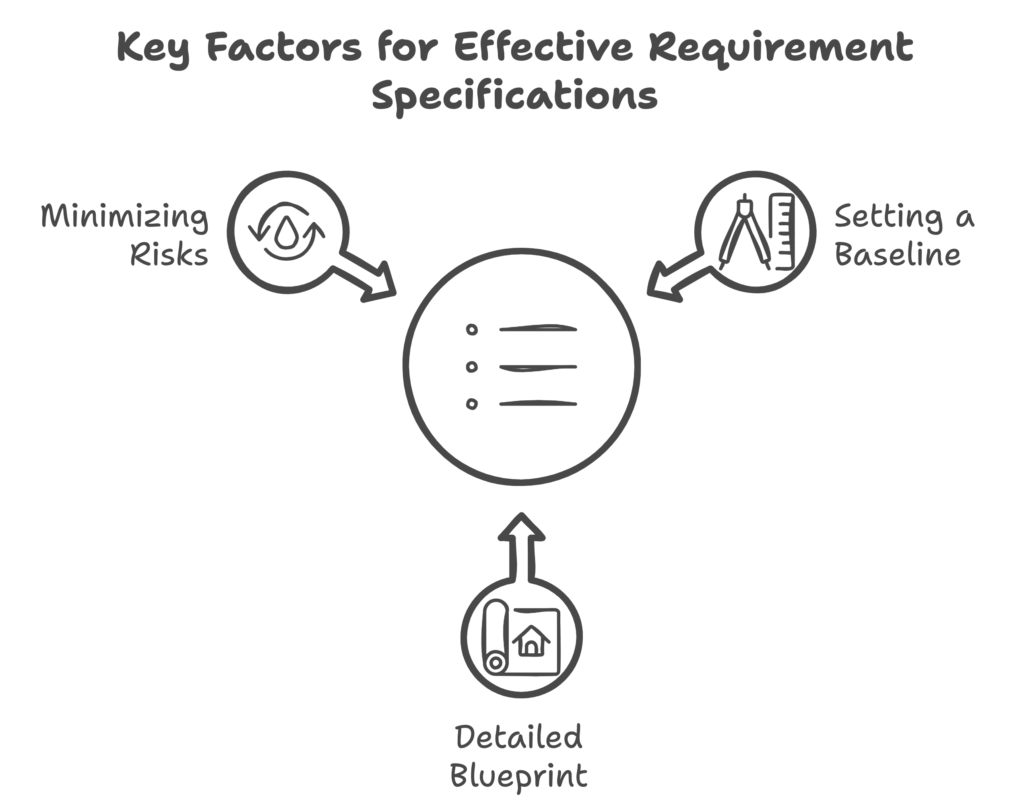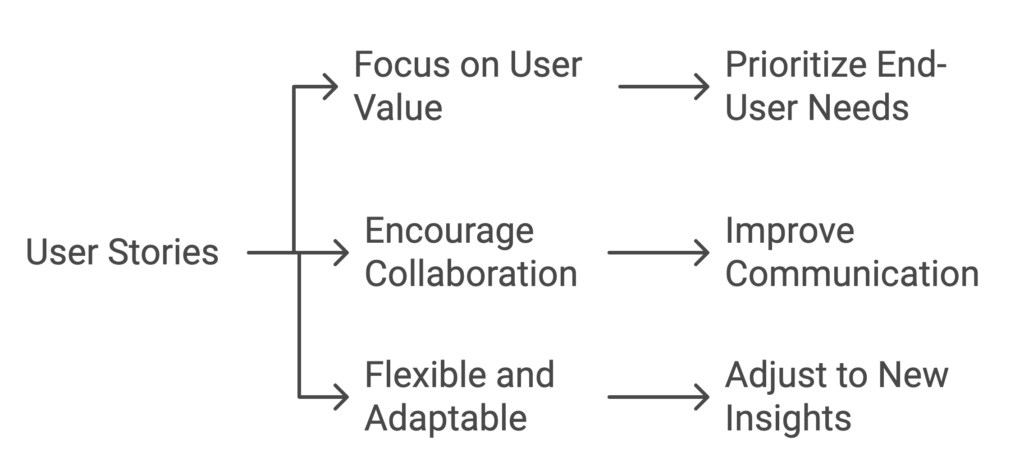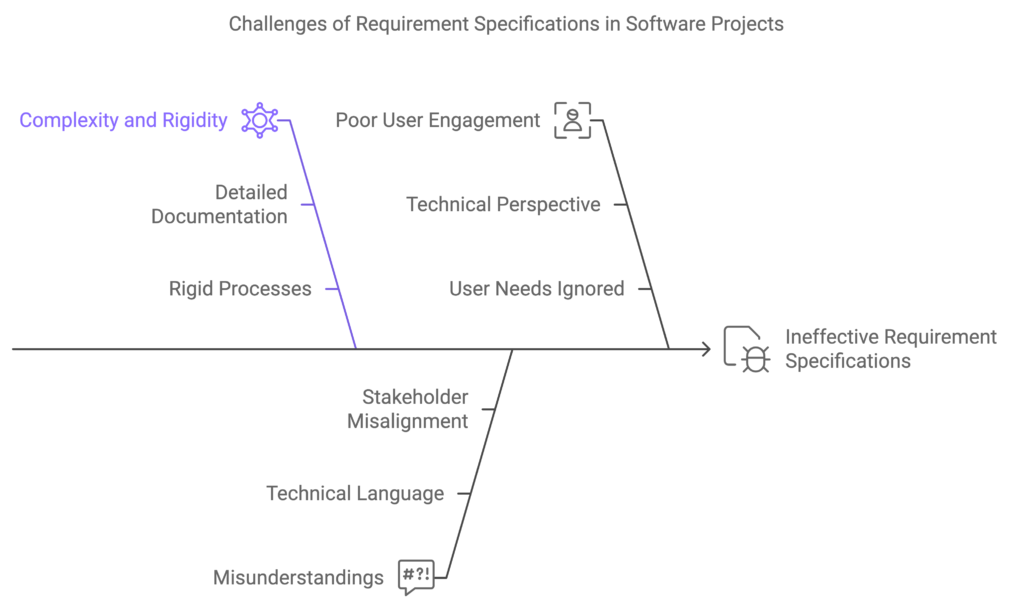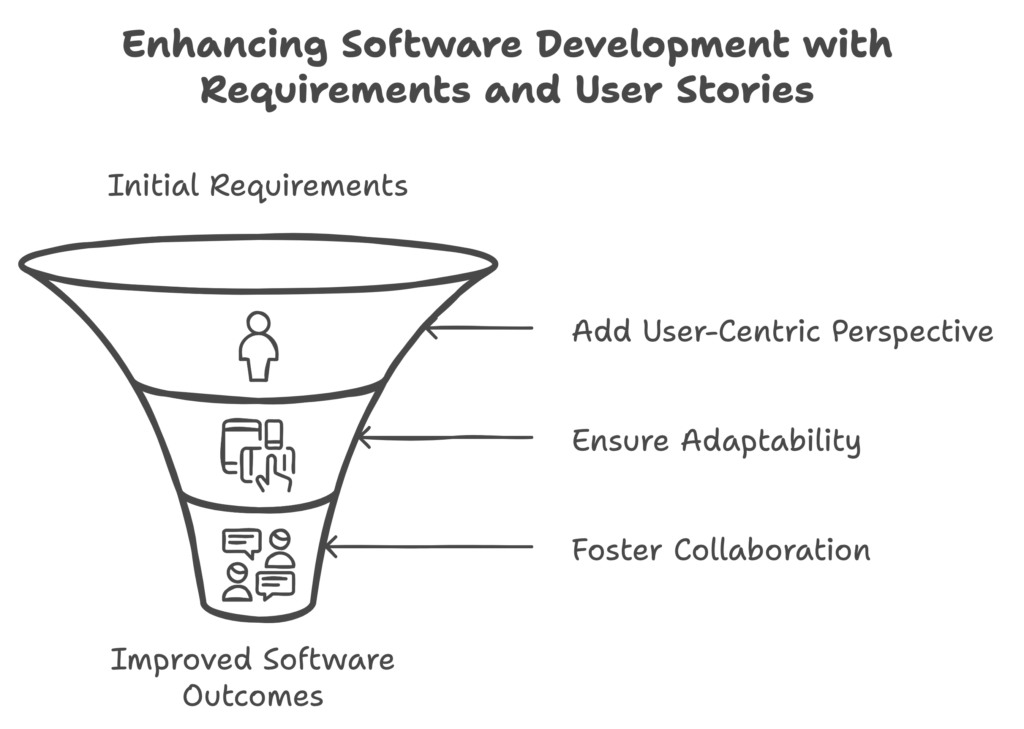Software development is a complex process that requires effective communication, adaptability, and a shared vision among everyone involved. For more insights into maximizing team efficiency and managing communication, read Transforming IT Cost Management: Discovering Synergies with Ellogy AI. Two key components in the software development lifecycle are requirement specifications and user stories. While they serve different purposes, combining these two methods can make a significant difference in delivering successful software projects. This article explains the differences, purposes, and synergies between requirement specifications and user stories, including how to avoid common pitfalls outlined in From Chaos to Clarity: Navigating Software Project Pitfalls, and how they can work together to bridge gaps in software development. So, let’s delve into Requirement Specification vs User Stories to understand how they complement each other.
What Are Requirement Specifications in Software Development?
Requirement specifications are all about gathering, documenting, and analyzing the needs and expectations of the stakeholders for a software system. This process is crucial in traditional software development because it sets the foundation for the rest of the project, such as design, development, and testing.
The Role of Requirement Specifications
Requirement specifications have several purposes in a software project:

- Setting a Baseline: Requirement specifications help establish the main features and functionality expected from the software. For a deeper understanding of setting clear goals, check out Unlock BRDs: Your Passport to Project Success. They create a shared understanding between the stakeholders and the development team.
- Detailed Blueprint: A requirement specification is like a detailed plan that explains what the software should do, how it should work, and the expected outcome. It often includes implementation details to guide the development team in building the required features.
- Minimizing Risks: By defining everything upfront, requirement specifications help minimize unexpected changes, ensuring that everyone has the same understanding of what will be delivered, which reduces risks during the project.
However, requirement specifications can be challenging. Because these documents are so detailed and rigid, they can lead to misunderstandings, especially if the requirements change over time. This lack of flexibility can create a gap between what stakeholders envisioned initially and what users need when the software is finished.
What Are User Stories and Why Are They Important?
User stories are a key part of agile development methods. They are short, simple descriptions of a software feature from an end-user’s perspective. Written in everyday language, user stories help foster good communication between the development team and stakeholders.
Defining User Stories
A user story is typically written in the format:
As a [user type], I want to [action] so that [goal or benefit].
For example, “As a new customer, I want to create an account to purchase products easily.” This simple format helps capture user needs clearly and straightforwardly.
The Benefits of Using User Stories
User stories come with several advantages:

- Focus on User Value: User stories emphasize “why to build” something rather than just “what to build,” focusing on the value for the end-user.
- Encourage Collaboration: User stories start conversations. They encourage collaboration between stakeholders, product owners, and developers to understand the user’s needs better.
- Flexible and Adaptable: Unlike requirement specifications, user stories are flexible. They can change as the understanding of user needs grows, helping teams adapt to new insights and changing requirements.
However, user stories don’t provide the same level of detail as requirement specifications. This lack of detail can lead to ambiguity if user stories aren’t supplemented with further discussion or documentation.
Challenges of Requirement Specifications in Software Projects

1. Complexity and Rigidity
One major challenge with requirement specifications is that they are often too detailed and rigid. This can lead to unnecessary complexity, contributing to issues like the hidden costs of poor software planning discussed in The Hidden Costs of Poor Software Planning. Teams may spend a lot of time documenting every aspect of a system, including technical details. This can lead to problems when requirements change, which they often do.
A rigid specification means developers have to go through complicated processes to make changes, which slows the project and sometimes makes it hard to meet users’ real needs.
2. Misunderstandings
The detailed and often technical language in requirement specifications can cause misunderstandings among stakeholders, developers, and testers. These misunderstandings can lead to features that don’t align with the original vision or user needs, wasting time and effort.
3. Poor User Engagement
Requirement specifications are written from a technical point of view and often miss the user’s perspective. While they are good at explaining how a system should work, they may not always reflect what users want or need.
User Stories: The User-Centered Approach
Unlike requirement specifications, user stories are user-centered. They help teams think from the user’s perspective and focus on what the user wants to achieve rather than just the technical aspects of implementation.
Real-Life Examples of User Stories
Consider a food delivery app. Instead of specifying technical requirements like “the system shall allow users to log in,” user stories focus on the value, such as:
“As a user, I want to save my favorite restaurants so I can easily find them next time I order.”
This approach helps teams focus on value delivery, ensuring that the features developed serve an actual purpose for the end user.
Bridging the Gap: The Need for a Hybrid Approach
The gap between requirement specifications and user stories represents the difference between what is being built and why it is being built. Requirement specifications provide a detailed technical plan but often lack user-centered insights, as highlighted in Lost in Translation: How Vague Goals Harm Software Development, while user stories focus on the value and outcome for users. Bridging this gap can help ensure alignment between what stakeholders want and what gets delivered.
A Hybrid Approach
Including user stories during the requirement specifications can bring out the best of both:

- Structured Requirements with User-Centric Perspective: Requirement specifications provide structure and clarity, while user stories add a user-focused perspective. Together, they ensure that the software works as expected and provides value to users.
- Adaptability with Detail: User stories are adaptable, while requirement specifications provide necessary detail. This combination allows teams to adapt to changes without losing the clarity detailed documentation provides.
- Improved Collaboration: User stories encourage conversations among developers, designers, testers, and stakeholders. These conversations can help make requirement specifications more detailed and accurate.
Implementing Agile Approaches to Balance Requirements
Agile methods focus on adaptability, collaboration, and incremental development—all of which work well with user stories. To learn more about agile tools and techniques, explore AI Prompt Engineering: What It Is and 15 Techniques for 2024. Here’s how agile approaches help balance requirement specifications and user stories:
- Iterative Development: Agile teams work in sprints, iterating on small parts of the system, often using user stories as the basis for development. This means requirements can evolve, and stakeholder feedback can be incorporated quickly.
- Frequent Feedback Loops: Agile methods encourage frequent feedback from stakeholders. User stories are developed, tested, and reviewed in short cycles, making sure any misalignment with user needs is corrected early.
- Backlog Grooming: The product backlog, which contains all user stories, is continuously reviewed and prioritized. Requirement specifications can be updated as new user stories emerge or change.
Continuous Delivery in Agile Development
Continuous delivery (CD) is a modern approach that fits well with agile methods. CD automates the building, testing, and deployment of software, making sure the product is always in a releasable state.
The Role of Continuous Delivery
- Speed and Reliability: With continuous delivery, teams can release features faster and more reliably. This aligns with the incremental and iterative nature of user stories, allowing the team to deliver value to end-users continuously.
- Incorporating User Feedback: Continuous delivery lets teams integrate user feedback quickly. When new user stories are introduced, CD ensures these changes are tested and deployed fast, keeping the product aligned with user needs.
- Reduced Risk: Since new features are automatically tested before deployment, continuous delivery reduces the risk of bugs slipping through, which leads to a higher quality product that matches both requirement specifications and user stories.
Bridging Requirement Specifications and User Stories with Practical Tools
To bridge the gap between requirement specifications and user stories, teams can use several practical tools and practices. You can also leverage AI tools to help automate and streamline the process, as discussed in AI Tools You Shouldn’t Miss: A Practical Guide. Here are some that are particularly helpful:
- User Story Mapping: User story mapping is a visual exercise that helps teams organize user stories into a structure that shows the journey users take with the product. This helps align user stories with requirement specifications by showing the big picture and detailed steps.
- Documentation Tools: Tools like Ellogy, Jira, and Azure DevOps provide spaces where requirement specifications and user stories can be linked. This ensures everyone has a shared understanding of both high-level goals and detailed implementation.
- Behavior-Driven Development (BDD): BDD uses user stories to write acceptance tests that can be automated. This helps align user needs with technical requirements by creating documentation that shows how the system should behave from both a user and technical point of view.
Creating a Smooth Workflow Between Stakeholders and Developers
Good communication and collaboration are essential to bridge the gap between requirement specifications and user stories. Miscommunication can severely derail software projects, as explained in Understanding the Gravity of Miscommunication in IT Projects. Here’s how teams can create a smooth workflow:
- Regular Check-ins and Refinement Sessions: Scheduling regular sessions to refine requirement specifications and user stories helps everyone stay aligned with evolving project goals. These sessions can address ambiguities, reassess priorities, and ensure everyone is on the same page.
- Cross-functional Team Involvement: Requirement specifications are often created by business analysts, while product owners usually write user stories. By involving different team members, like developers, designers, and testers, the process of creating specifications and user stories can be more cohesive.
- Living Documentation: Requirement specifications shouldn’t be static. They must change, particularly when considering insights from How AI Can Enhance Software Development: A Deep Dive. They need to change as user stories evolve. Keeping living documentation means updating specifications whenever user stories or requirements change, keeping everything aligned.
Common Pitfalls in Requirement Specifications and User Stories
1. Over-detailed Specifications
One common pitfall with requirement specifications is having too much detail too early. When specifications try to define every single detail before development, they can limit flexibility. It’s important to balance being thorough with staying adaptable.
2. Vague User Stories
User stories can sometimes be too vague. A story like, “As a user, I want to upload documents” might lack enough context or detail. Adding acceptance criteria and having ongoing discussions can help make user stories clearer.
3. Ignoring the End-User
Both requirement specifications and user stories should focus on the end-user. However, it’s easy to get caught up in technical details and forget about the user’s real needs. To avoid this, teams should use techniques like user personas to make sure all requirements are framed with the user’s perspective in mind.
Conclusion: A Balanced, Collaborative Approach
To achieve successful software projects, it’s important to bridge the gap between requirement specifications and user stories. Both are valuable when used together, providing a solid foundation for developing software that is both technically sound and user-focused.
Using requirement specifications gives teams a well-documented vision of the project’s goals and functionalities. Adding user stories helps keep that vision focused on user value, adaptability, and collaboration. This combined approach results in a product that is technically strong and meets user expectations, leading to higher satisfaction.
Continuous delivery makes this approach even stronger by allowing quick feedback loops and fast integration of user input, helping software development stay agile, relevant, and efficient.
The world of software development is changing fast, especially with the rise of generative AI, which is transforming how software projects are executed, as highlighted in Future Innovations with Generative AI, and understanding how to handle both detailed and user-focused requirements can make a big difference for project success. Bridging the gap between requirement specifications and user stories lets teams build functional software that delivers real value to users, meeting the changing demands of the market.
FAQ
1. What are the main differences between requirement specifications and user stories?
Requirement specifications are detailed, technical descriptions outlining system functions, while user stories are brief, flexible descriptions focusing on user needs and goals.
2. How can agile methodologies benefit software development?
Agile methodologies emphasize adaptability, iterative development, and stakeholder collaboration, making them well-suited for the dynamic nature of software projects.
3. What role does continuous delivery play in this context?
Continuous delivery facilitates rapid and reliable software building, testing, and release, aligning with agile principles and allowing quick integration of user feedback.
4. How can requirement specifications and user stories be used together effectively?
Using both together ensures that projects are well-documented while staying user-focused. Requirement specifications provide the technical details needed for development, while user stories keep the user value front and center, resulting in a balanced and successful product.
5. Why is user engagement important in requirement gathering?
User engagement ensures that the requirements gathered are aligned with actual user needs. By actively involving users in the process through user stories and feedback sessions, teams can develop software that provides real value and meets user expectations.
6. Can requirement specifications evolve over time?
Yes, requirement specifications should be treated as living documents that evolve as the understanding of user needs and project scope grows. Keeping these documents flexible allows teams to adapt to new requirements without losing sight of the project’s overall vision.





